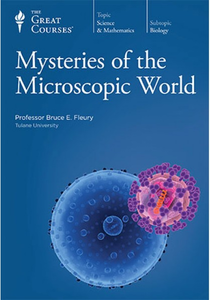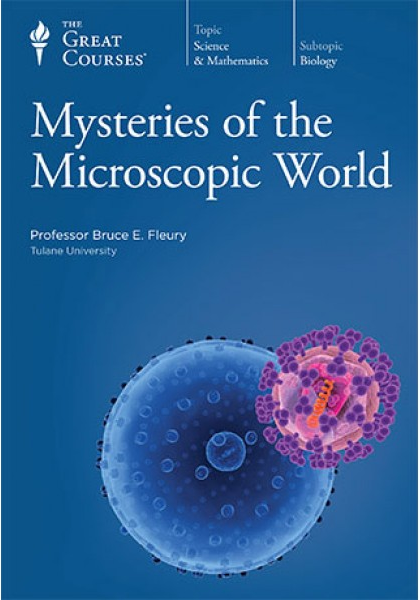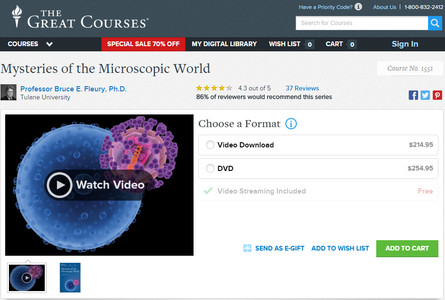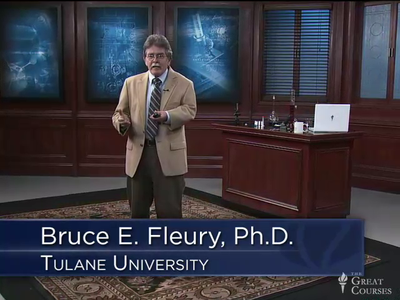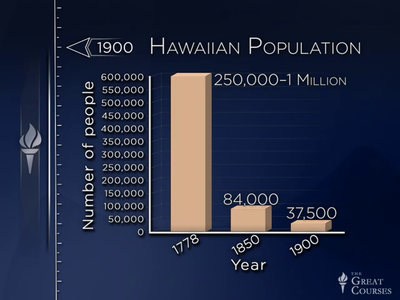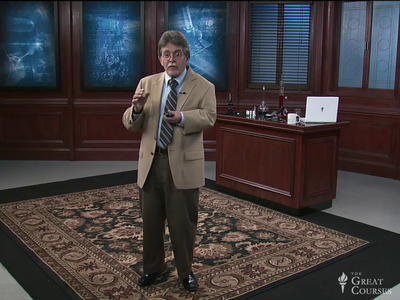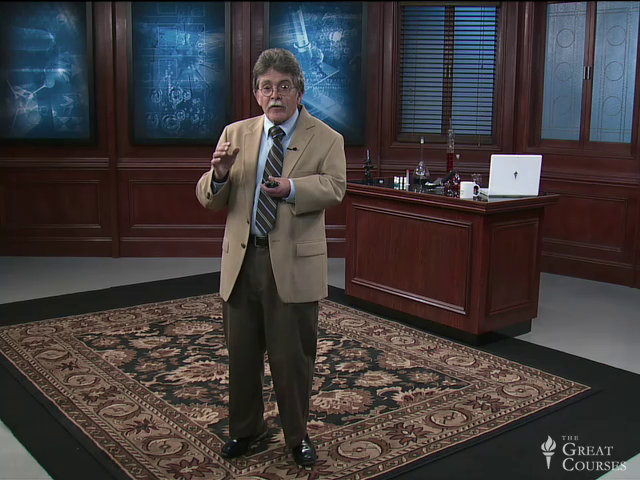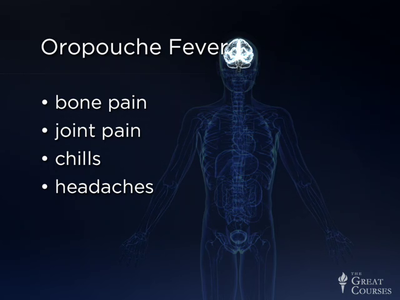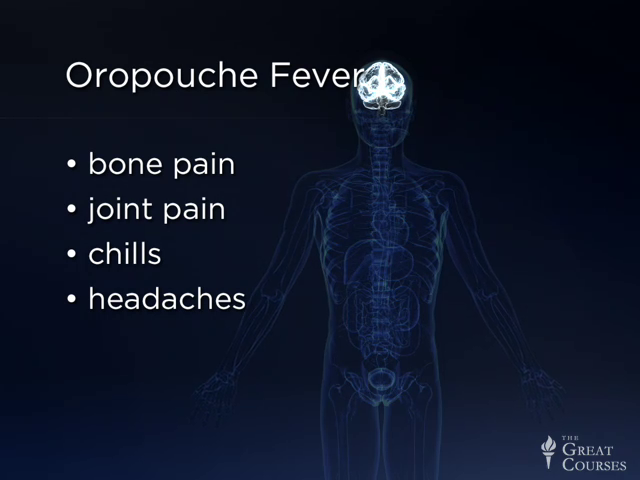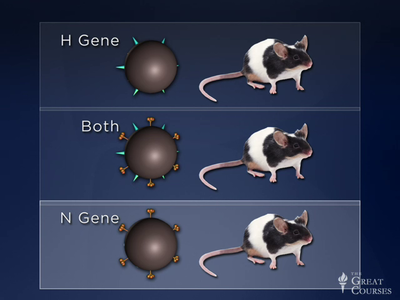The Great Courses - Mysteries of the Microscopic World
24xWEBRip | English | M4V | 640 x 480 | AVC ~1500 kbps | 29.970 fps
AAC | 128 kbps | 44.1 KHz | 2 channels | 24 lectures of 30 minutes | + PDF eBook | 8.14 GB
AAC | 128 kbps | 44.1 KHz | 2 channels | 24 lectures of 30 minutes | + PDF eBook | 8.14 GB
Genre: eLearning / Education lectures: Biology, Genetics
An invisible world of astonishing complexity is all around you. A world so small you can't see it with the naked eye. A world so crowded that its population staggers the mind. A world in which you participate every day—often without even knowing it.Whatever the situation, being able to speak in public is essential to success. You can have the most logical argument possible, but in order to truly teach, inform, persuade, or defend, you need to present your ideas with conviction and confidence.
Yet this is often easier said than done. Many of us have a deep fear of public speaking. Or we think it's just an intuitive talent that can't be learned. But according to award-winning Professor John R. Hale of the University of Louisville, a masterful public speaker who has delivered more than 1,000 speeches to all manner of audiences, that couldn't be further from the truth.
The inhabitants of this world are trillions of bacteria, viruses, fungi, and other organisms, collectively known as microbes. Hundreds of thousands could fit on the period at the end of this sentence. And many play a powerful role in your life, from the bacteria in your stomach that help you digest food to the pathogens that make you sick.
Mysteries of the Microscopic World is your illustrated guided tour through a realm that is as teeming with exotic life as any rainforest—and that is just as exciting. Presented by award-winning Professor Bruce E. Fleury of Tulane University, these 24 half-hour lectures tell the story of
how microbes evolved;
how they function;
how humans discovered them;
how they harm and also help us; and
how we compete, coexist, and coevolve.
A Spellbinding Narrative
Assuming no background in science, Mysteries of the Microscopic World teaches you all the biology you need to understand cells as the basic unit of life, DNA as the amazingly versatile genetic code, the immune system as an almost miraculous arsenal of defenses, and other features of the tiny domain where microbes thrive. Among the intriguing concepts you encounter are these:
Coevolution: Civilization and microbes have grown up together—in beneficial associations such as bread- and winemaking, and less fortunate relationships such as the pandemics that have periodically changed the course of history.
Extremophiles: On Earth, microbes flourish in environments of punishing heat, cold, acidity, and saltiness, where nothing else can survive. These "extremophiles" may be clues to what life is like on other planets.
Cyanobacteria: Earth owes its oxygen-rich atmosphere to the evolution of photosynthetic cyanobacteria. These tiny organisms were so successful that they dominated the planet for nearly two billion years.
Darwinian medicine: Outsmarting disease-causing organisms means understanding how they evolved to make us sick and how they adapted to defeat our treatments. In medicine, it pays to think like Darwin.
Cytokine storm: When people in the prime of life are felled by an epidemic, it could be because the pathogen induces a "cytokine storm," an immune system overreaction—as happened to millions of young people in the deadly 1918 flu.
Professor Fleury weaves these and many other stories into a spellbinding narrative that takes you from the germ theory of disease to germ warfare, from the challenges of being small to the advantages of infecting through a "vector" intermediary, from ancient prokaryotes to the latest probiotics. After watching these lectures, you will be able to follow with deeper understanding news reports about epidemics, vaccine research, antibiotic-resistant germs, bioterrorism, and many other topics about the microbial world.
Evolutionary Arms Race
In our ceaseless contact with microbes, the good news is that some age-old diseases are being defeated. Smallpox, a scourge as ancient as human history, was eradicated in the late 1970s, and similar campaigns are underway against polio, leprosy, and guinea-worm.
But the bad news is that many microbes mutate astonishingly quickly, making them highly adaptable in the evolutionary arms race with each other and with us. The following battles, covered in detail in this course, are still inconclusive:
HIV/AIDS: Only 50 years have passed since HIV first appeared in humans, which is not long enough for the body to evolve an effective defense—or for HIV to coevolve to a less virulent strain. The most worrisome scenario is for the virus to mutate into an airborne form.
Multiple drug resistance: In 1952, penicillin could cure virtually any infection caused by Staphylococcus. No more. Today, the bane of hospitals is the multidrug-resistant Staph strain MRSA. Even more troubling is a resistant strain of Streptococcus dubbed flesh-eating bacteria.
Killer flu: The deadliest epidemic of all time was the 1918 flu, killing an estimated 50 to 100 million people. Starting as a normal flu, it mutated into an unusually virulent form. Scientists have recovered samples of the virus from victims of the era so they can sound the alarm when a similar flu type appears.
A Scientific Detective Story
Just as interesting as the microbes are the scientists who discovered and charted this microscopic realm. It's easy to forget that the cause of plagues and even the existence of microorganisms were a complete mystery for thousands of years, until the work of science detectives such as Louis Pasteur and Robert Koch, who laid the foundations for bacteriology; or Alexander Fleming, who discovered penicillin; or the unheralded Ernest Duchesne, who recognized the antibiotic properties of penicillin more than 30 years before Fleming, but whose work went unnoticed. Among the other pioneers of the microscopic world that you learn about are these:
Ignaz Semmelweis: Working in Vienna in the 1840s, Semmelweis linked his hospital's high mortality rate among women in childbirth with their treatment by staff members who did frequent autopsies. The solution, washing hands with disinfectant, was rejected by his offended colleagues.
Alexandre Yersin: When the bubonic plague struck China in the 1890s, this Swiss bacteriologist rushed to the scene. Together with a Japanese researcher, Dr. Kitasato, he discovered the plague bacillus, identifying the pathogen that had menaced the world for centuries.
Stanley Miller: Microbial and other life had to start with complex biomolecules. In the 1950s, graduate student Stanley Miller, working under Nobel laureate Harold Urey, performed a brilliant experiment showing that the chemical precursors of life formed naturally in conditions thought to exist on the early Earth.
World of Wonder
The winner of two Mortar Board Awards for outstanding teaching from Tulane University, Professor Fleury has a gift for making science accessible to non-scientists. In Mysteries of the Microscopic World, he tackles the ideal subject, one that is unusually rich in historical and cultural connections, human stories, intriguing technical details, and relevance to the daily lives of everyone. "This is one of the most fascinating areas in biology," he notes, "not just because of the value we get from knowing how and why we get sick, but because of the sheer beauty of what's going on at the microscopic level."
After viewing this course, he says, "you'll never feel quite the same way about the world again, because wherever you go, whatever you do, you'll be more aware of all the creatures that are living around you, hidden by their small size."
Mysteries of the Microscopic World is your illustrated guided tour through a realm that is as teeming with exotic life as any rainforest—and that is just as exciting. Presented by award-winning Professor Bruce E. Fleury of Tulane University, these 24 half-hour lectures tell the story of
how microbes evolved;
how they function;
how humans discovered them;
how they harm and also help us; and
how we compete, coexist, and coevolve.
A Spellbinding Narrative
Assuming no background in science, Mysteries of the Microscopic World teaches you all the biology you need to understand cells as the basic unit of life, DNA as the amazingly versatile genetic code, the immune system as an almost miraculous arsenal of defenses, and other features of the tiny domain where microbes thrive. Among the intriguing concepts you encounter are these:
Coevolution: Civilization and microbes have grown up together—in beneficial associations such as bread- and winemaking, and less fortunate relationships such as the pandemics that have periodically changed the course of history.
Extremophiles: On Earth, microbes flourish in environments of punishing heat, cold, acidity, and saltiness, where nothing else can survive. These "extremophiles" may be clues to what life is like on other planets.
Cyanobacteria: Earth owes its oxygen-rich atmosphere to the evolution of photosynthetic cyanobacteria. These tiny organisms were so successful that they dominated the planet for nearly two billion years.
Darwinian medicine: Outsmarting disease-causing organisms means understanding how they evolved to make us sick and how they adapted to defeat our treatments. In medicine, it pays to think like Darwin.
Cytokine storm: When people in the prime of life are felled by an epidemic, it could be because the pathogen induces a "cytokine storm," an immune system overreaction—as happened to millions of young people in the deadly 1918 flu.
Professor Fleury weaves these and many other stories into a spellbinding narrative that takes you from the germ theory of disease to germ warfare, from the challenges of being small to the advantages of infecting through a "vector" intermediary, from ancient prokaryotes to the latest probiotics. After watching these lectures, you will be able to follow with deeper understanding news reports about epidemics, vaccine research, antibiotic-resistant germs, bioterrorism, and many other topics about the microbial world.
Evolutionary Arms Race
In our ceaseless contact with microbes, the good news is that some age-old diseases are being defeated. Smallpox, a scourge as ancient as human history, was eradicated in the late 1970s, and similar campaigns are underway against polio, leprosy, and guinea-worm.
But the bad news is that many microbes mutate astonishingly quickly, making them highly adaptable in the evolutionary arms race with each other and with us. The following battles, covered in detail in this course, are still inconclusive:
HIV/AIDS: Only 50 years have passed since HIV first appeared in humans, which is not long enough for the body to evolve an effective defense—or for HIV to coevolve to a less virulent strain. The most worrisome scenario is for the virus to mutate into an airborne form.
Multiple drug resistance: In 1952, penicillin could cure virtually any infection caused by Staphylococcus. No more. Today, the bane of hospitals is the multidrug-resistant Staph strain MRSA. Even more troubling is a resistant strain of Streptococcus dubbed flesh-eating bacteria.
Killer flu: The deadliest epidemic of all time was the 1918 flu, killing an estimated 50 to 100 million people. Starting as a normal flu, it mutated into an unusually virulent form. Scientists have recovered samples of the virus from victims of the era so they can sound the alarm when a similar flu type appears.
A Scientific Detective Story
Just as interesting as the microbes are the scientists who discovered and charted this microscopic realm. It's easy to forget that the cause of plagues and even the existence of microorganisms were a complete mystery for thousands of years, until the work of science detectives such as Louis Pasteur and Robert Koch, who laid the foundations for bacteriology; or Alexander Fleming, who discovered penicillin; or the unheralded Ernest Duchesne, who recognized the antibiotic properties of penicillin more than 30 years before Fleming, but whose work went unnoticed. Among the other pioneers of the microscopic world that you learn about are these:
Ignaz Semmelweis: Working in Vienna in the 1840s, Semmelweis linked his hospital's high mortality rate among women in childbirth with their treatment by staff members who did frequent autopsies. The solution, washing hands with disinfectant, was rejected by his offended colleagues.
Alexandre Yersin: When the bubonic plague struck China in the 1890s, this Swiss bacteriologist rushed to the scene. Together with a Japanese researcher, Dr. Kitasato, he discovered the plague bacillus, identifying the pathogen that had menaced the world for centuries.
Stanley Miller: Microbial and other life had to start with complex biomolecules. In the 1950s, graduate student Stanley Miller, working under Nobel laureate Harold Urey, performed a brilliant experiment showing that the chemical precursors of life formed naturally in conditions thought to exist on the early Earth.
World of Wonder
The winner of two Mortar Board Awards for outstanding teaching from Tulane University, Professor Fleury has a gift for making science accessible to non-scientists. In Mysteries of the Microscopic World, he tackles the ideal subject, one that is unusually rich in historical and cultural connections, human stories, intriguing technical details, and relevance to the daily lives of everyone. "This is one of the most fascinating areas in biology," he notes, "not just because of the value we get from knowing how and why we get sick, but because of the sheer beauty of what's going on at the microscopic level."
After viewing this course, he says, "you'll never feel quite the same way about the world again, because wherever you go, whatever you do, you'll be more aware of all the creatures that are living around you, hidden by their small size."
Course Lecture Titles:
1 The Invisible Realm
2 Stone Knives to Iron Plows
3 The Angel of Death
4 Germ Theory
5 The Evolutionary Arms Race
6 Microbial Strategies
7 Virulence
8 Death by Chocolate
9 Bambi's Revenge
10 The Germ of Laziness
11 The 1918 Flu—A Conspiracy of Silence
12 The 1918 Flu—The Philadelphia Story
13 The 1918 Flu—The Search for the Virus
14 Immunity—Self versus Non-Self
15 Adaptive Immunity to the Rescue
16 AIDS—The Quiet Killer
17 The Deadly Strategy of AIDS
18 Autoimmunity—Self versus Self
19 Allergies and Asthma
20 Microbes as Weapons
21 Pandora’s Box
22 Old World to New
23 Close Encounters of the Microbial Kind
24 Microbes as Friends
General
Complete name : 08. Death by Chocolate.m4v
Format : MPEG-4
Codec ID : M4V
File size : 325 MiB
Duration : 27mn 47s
Overall bit rate mode : Variable
Overall bit rate : 1 633 Kbps
Movie name : Lect.08 Death by Chocolate
Album : Mysteries of the Microscopic World
Album/Performer : The Great Courses
Track name/Position : 8
Track name/Total : 24
Grouping : Mysteries of the Microscopic World
Compilation : Yes
Performer : Prof. Bruce E. Fleury
Composer : The Great Courses
Genre : Books & Spoken
Recorded date : 2011
Encoded date : UTC 2011-07-26 01:56:40
Tagged date : UTC 2011-08-09 14:35:20
Cover : Yes
tvsh : Mysteries of the Microscopic World
tvsn : 1551
soal : Mysteries of the Microscopic World
soar : Prof. Bruce E. Fleury
soaa : The Great Courses
soco : The Great Courses
sosn : Mysteries of the Microscopic World
tven : Lect.08 Death by Chocolate
tves : 8
sonm : Lect.08 Death by Chocolate
Video
ID : 1
Format : AVC
Format/Info : Advanced Video Codec
Format profile : Baseline@L3.0
Format settings, CABAC : No
Format settings, ReFrames : 1 frame
Codec ID : avc1
Codec ID/Info : Advanced Video Coding
Duration : 27mn 47s
Bit rate mode : Constant
Bit rate : 1 500 Kbps
Maximum bit rate : 3 743 Kbps
Width : 640 pixels
Height : 480 pixels
Display aspect ratio : 4:3
Frame rate mode : Constant
Frame rate : 29.970 fps
Color space : YUV
Chroma subsampling : 4:2:0
Bit depth : 8 bits
Scan type : Progressive
Bits/(Pixel*Frame) : 0.163
Stream size : 298 MiB (92%)
Encoded date : UTC 2011-07-26 01:56:40
Tagged date : UTC 2011-07-26 01:56:40
Audio
ID : 2
Format : AAC
Format/Info : Advanced Audio Codec
Format profile : LC
Codec ID : 40
Duration : 27mn 47s
Bit rate mode : Variable
Bit rate : 128 Kbps
Maximum bit rate : 137 Kbps
Channel(s) : 2 channels
Channel positions : Front: L R
Sampling rate : 44.1 KHz
Compression mode : Lossy
Stream size : 25.0 MiB (8%)
Encoded date : UTC 2011-07-26 01:56:40
Tagged date : UTC 2011-08-09 14:35:20
Complete name : 08. Death by Chocolate.m4v
Format : MPEG-4
Codec ID : M4V
File size : 325 MiB
Duration : 27mn 47s
Overall bit rate mode : Variable
Overall bit rate : 1 633 Kbps
Movie name : Lect.08 Death by Chocolate
Album : Mysteries of the Microscopic World
Album/Performer : The Great Courses
Track name/Position : 8
Track name/Total : 24
Grouping : Mysteries of the Microscopic World
Compilation : Yes
Performer : Prof. Bruce E. Fleury
Composer : The Great Courses
Genre : Books & Spoken
Recorded date : 2011
Encoded date : UTC 2011-07-26 01:56:40
Tagged date : UTC 2011-08-09 14:35:20
Cover : Yes
tvsh : Mysteries of the Microscopic World
tvsn : 1551
soal : Mysteries of the Microscopic World
soar : Prof. Bruce E. Fleury
soaa : The Great Courses
soco : The Great Courses
sosn : Mysteries of the Microscopic World
tven : Lect.08 Death by Chocolate
tves : 8
sonm : Lect.08 Death by Chocolate
Video
ID : 1
Format : AVC
Format/Info : Advanced Video Codec
Format profile : Baseline@L3.0
Format settings, CABAC : No
Format settings, ReFrames : 1 frame
Codec ID : avc1
Codec ID/Info : Advanced Video Coding
Duration : 27mn 47s
Bit rate mode : Constant
Bit rate : 1 500 Kbps
Maximum bit rate : 3 743 Kbps
Width : 640 pixels
Height : 480 pixels
Display aspect ratio : 4:3
Frame rate mode : Constant
Frame rate : 29.970 fps
Color space : YUV
Chroma subsampling : 4:2:0
Bit depth : 8 bits
Scan type : Progressive
Bits/(Pixel*Frame) : 0.163
Stream size : 298 MiB (92%)
Encoded date : UTC 2011-07-26 01:56:40
Tagged date : UTC 2011-07-26 01:56:40
Audio
ID : 2
Format : AAC
Format/Info : Advanced Audio Codec
Format profile : LC
Codec ID : 40
Duration : 27mn 47s
Bit rate mode : Variable
Bit rate : 128 Kbps
Maximum bit rate : 137 Kbps
Channel(s) : 2 channels
Channel positions : Front: L R
Sampling rate : 44.1 KHz
Compression mode : Lossy
Stream size : 25.0 MiB (8%)
Encoded date : UTC 2011-07-26 01:56:40
Tagged date : UTC 2011-08-09 14:35:20
ScreenShots
Exclusive eLearning Videos ParRus-blog ← add to bookmarks
Feel free to contact me PM
when links are dead or want any repost
Feel free to contact me PM
when links are dead or want any repost


